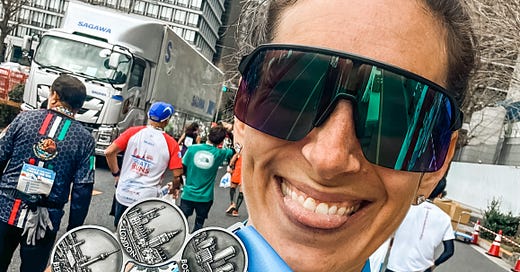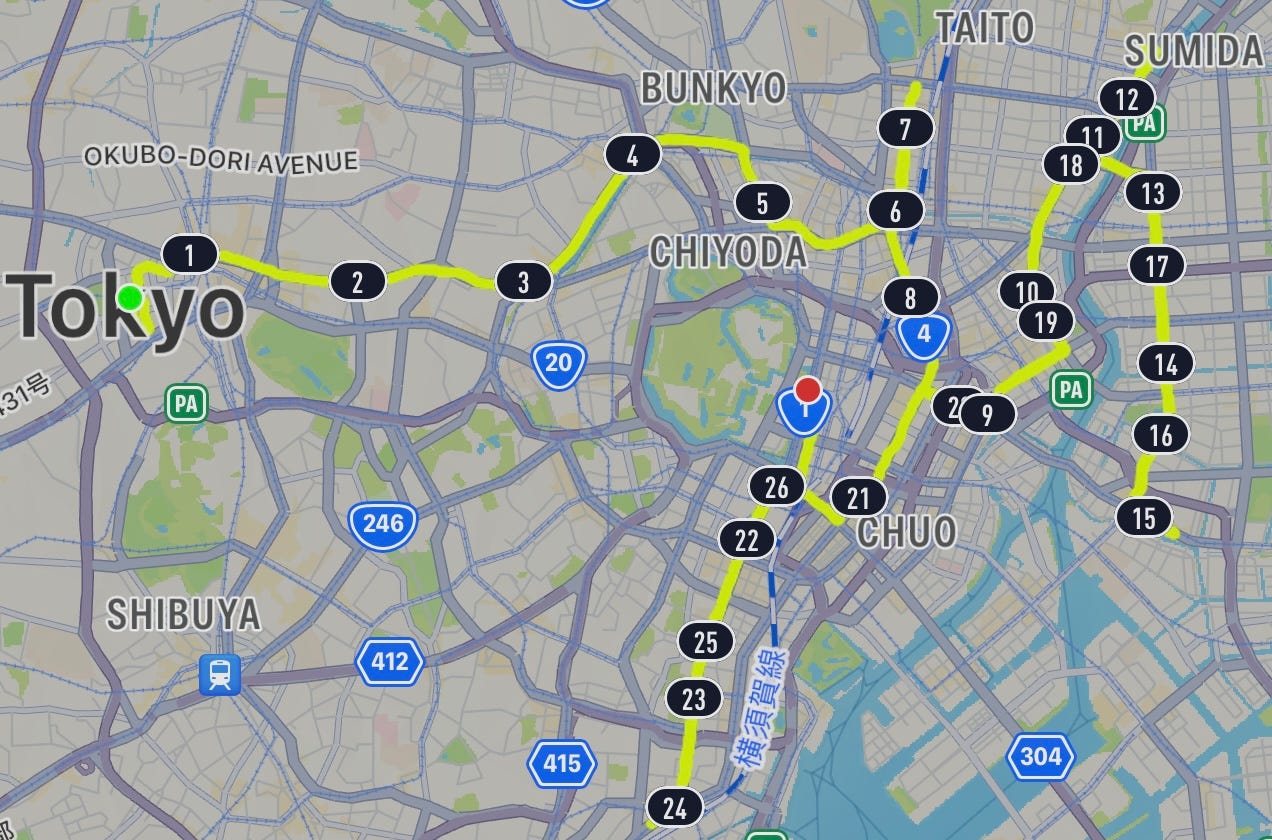Six Stars 🤯 I honestly didn’t know how emotional I’d be about this until walking up to the Tokyo Marathon start line on Sunday.
Quick refresher: There are six Abbott World Marathon Majors: the New York, Chicago, Boston, London, Berlin, and Tokyo Marathons. These are generally considered the most popular and prestigious marathon in the world, and if you finish all six, you get a fancy medal. I ran Boston in 2016, NYC in 2016 (and ‘17, ‘18, ‘21, and ‘22), Berlin in 2018 (and ‘22), London in 2019, and Chicago in 2021. I was supposed to run the Tokyo Marathon in 2020, but it was canceled last minute due to the COVID-19 pandemic. Foreigners weren’t allowed back into Japan until October 2022.
So this year’s Tokyo Marathon was a big deal for runners like me who’ve been waiting to race since 2019. It was also going to be a record-breaking race: More than 3,000 participants would be aiming to complete their Six Star journey, which would be a Guinness World Record. And the total number of finishers since the Six Star program began would pass 10,000.
Anyway, all of this created a practically tangible atmosphere of excited energy at the Tokyo Marathon start line, near the Tokyo Metropolitan Government Building in Shinjuku. This race is one of the smaller of the Majors, with 38,000 runners (FYI: only 12,000 of those are from overseas), and yet it felt more crowded than any of the other five—yes, including New York. I’m pretty sure it was a rolling start, because once the gun went off, we were all moving en masse towards the start line and I’ve never felt so packed in in the first mile of a race as I did here.
I had three non-time goals for this race: to finish and get my Six Star medal, to not hate my life while doing it, and to run a smart race. The plan was to run the first three miles about 10 seconds slower than goal pace, settle in for the next 10 miles at about five seconds slower than goal pace, run miles 13 to 20 at a few seconds faster than goal pace, and kick things up a notch in the final 10K.
The Tokyo Marathon course is pancake flat, with a beautiful downhill for the first four miles and barely any elevation gain for the first half. The second half had more gain, but no more than 10 feet per mile. That felt incredible—and of course I went out just a little too fast, so once I settled in I focused on just maintaining the pace so I’d still have some kick at the end.
The first five miles were a straight shot, then there were four big out-and-back loops (meaning we ran both sides of a single street). A lot of runners dislike this, because it means you’re seeing the same things twice, but I actually loved it here; I saw my faster friends multiple times on those out-and-backs, and the energy of the other runners added to the energy of the crowd (more on that in a second). The only one I hated was the final out and back, which stretched from mile 21 to 25.5 and felt absolutely interminable (I didn’t end up having that kick at the end, but I mostly managed to hang on).
I was nervous about the energy of the Tokyo Marathon, because I’d heard that it’s so different from American and European races. Think: instead of people screaming at you and shooting confetti guns and ringing cowbells for 26 miles, they’re politely golf-clapping and whisper-shouting “ganbare!”, which translates to “do your best.”
Fortunately, I found the crowd to be pretty amped for all the runners, and while they may not have been screaming (I had my headphones in anyway), there was tons of smiling and waving and clapping. Unfortunately, the most desolate part of the course was the hardest part, that out-and-back from mile 21 to 25.5. But the final mile was wall-to-wall spectators encouraging you over a tree-lined cobblestone street, and that mostly made up for the dearth of energy beforehand.
There was also a ton of camaraderie between the runners, and I went all in, wearing a bib pinned to my back that announced “today is the day!” and showed my Six Star journey. I made a point to tap on the back as many runners with the same bib on as I could when I passed and wish them congratulations, and many others did the same to me.
By the time I could see the finish line, I was sort of crying (I say sort of because I don’t think my body had a lot of liquid to spare at that point). When you do the math, I’ve run over 288 miles on World Marathon Majors courses, and that doesn’t take into account the minimum of 200 miles I’ve put into each training cycle for those marathons. Just in 16 weeks of training for Tokyo this year, I spent over 114 hours running, and logged 479 miles. It really hit me how much of the past eight years I’ve dedicated to this goal of running all six Majors, and what a huge accomplishment finally finishing them was. And not only did I finish my last Major, it was the fastest one I’ve run yet. I’m a little choked up just writing that.
Considering that my job revolves around writing about running and coaching other runners, it’s really easy to get caught up in the idea that marathoning is the norm. It’s not. Running 26.2 miles—whether you’re running just to finish or you’re running for a time goal or whatever your reason is for running—is a huge physical undertaking, one that deserves to be acknowledged and appreciated whether it’s a good day or a bad day out there. The Tokyo Marathon was one of the good days, and I’m so glad I finally got to experience it.
Thanks to ASICS for their support!
I have to shout out the custom ASICS singlet the brand gifted me for the Tokyo Marathon. I’ve done a ton of my training runs in the Actibreeze Jacquard Singlet, and I love how lightweight and breathable it is. ASICS had visual artist Itahara design my race singlet using the traditional Japanese sumi-e brush painting style; to the six cherry blossoms (which, in Japanese culture, symbolize both birth and death and beauty and violence) on the front, he added six stars representing each step of my Six Star journey. I loved it, and felt so honored to be wearing this design during the race. Check out the singlet on asics.com and see more of Itahara’s art here.
the rundown
Garmin Announces the Forerunner 265 Series and Forerunner 965
Garmin says these are the brand’s first dedicated GPS running smartwatches with AMOLED displays (they’re the successors to the Forerunner 255 and Forerunner 955) that use always-on, full color displays and responsive touchscreens in addition to the traditional 5-button design. Both have 8GB of storage and last, respectively, for 31 hours and up to 42 hours in GPS-only mode on a full charge; they also come with training tools like morning report, race widget, daily suggested workouts, training readiness, and HRV status. The Forerunner 965 is hardier, with a titanium bezel and Garmin’s largest AMOLED display at 1.4 inches, and also includes a new load ratio feature, which lets athletes track short-term to mid-term load ratio. The 265 is $599 and the 955 is $699.
Are You Lifting Heavy Enough?
Your one-rep max (1RM) is the heaviest load that can be successfully lifted once, and resistance training prescribes reps based on different percentages of that 1RM. But if you’re self-selecting your weights, you may not be lifting enough: In a 2022 systematic review published in the journal Sports Medicine, study participants selected loads equal to an average of 53 percent of 1RM across exercises, which, when used for five to 15 reps, could increase strength gains for novices, but not for more advanced lifters. Consider this your reminder to periodically work with a pro to make sure you’re doing enough to see gains.
Meet the Runner Who Leads Every Pack and Then Vanishes
I love learning about some of the lesser-known, less-celebrated people in the sport of running, and this New York Times profile of Eric Sowinski, a professional pacer, was interesting. I’ve run with an official pacer just once in a marathon, and he did a terrible job, finishing 11 minutes off the goal time (and two minutes behind me), so I can’t imagine the pressure of doing that with precision on a world stage. And the idea of running to lose is fascinating; I feel like so many people are driven by the desire to win, it’s interesting to get a peek inside a runner’s motivation to help others do that.
Ken Rideout on the Citius Mag Podcast
I flagged this podcast to listen to in advance of the Tokyo Marathon because Ken Rideout was attempting to win his third World Marathon Major 50-and-over division (he won New York in 2021 and Boston in 2022, and has come in second in London, Chicago, and Berlin.). He’s open about his struggles with additiction, and I appreciated his insights into how running can become its own kind of addiction and his journey to finding meaning behind his miles (I also loved his acknowledgement that super shoes aren’t a shortcut to speed). He’s also scarily intense, but in a way I think a lot of runners can relate to because running is a source of pride for him, a way to say “look at what I can do,” even if the only person you’re telling that to is yourself. You can read more about him in this recent Wall Street Journal profile. Oh, and he came in third in that age division in Tokyo—not bad.










such an incredible race
Huge congratulations on completing marathon majors. I am starting with my journey to complete marathon majors with Chicago 2023.